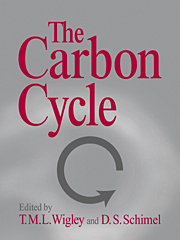Book contents
- Frontmatter
- Contents
- Preface
- Acknowledgments
- Contributors to the 1993 Global Change Institute
- I INTRODUCTION
- II THE MISSING CARBON SINK
- 3 Carbon Dioxide Emissions from Fossil Fuel Consumption and Cement Manufacture, 1751–1991, and an Estimate of Their Isotopic Composition and Latitudinal Distribution
- 4 Emissions of Carbon from Land-Use Change
- 5 The CO2 Fertilizing Effect: Relevance to the Global Carbon Cycle
- 6 Soils and the Global Carbon Cycle
- 7 Grasslands and the Global Carbon Cycle: Modeling the Effects of Climate Change
- 8 Constraints on the Atmospheric Carbon Budget from Spatial Distributions of CO2
- 9 Estimating Air–Sea Exchanges of CO2 from pCO2 Gradients: Assessment of Uncertainties
- 10 Atmospheric Oxygen Measurements and the Carbon Cycle
- 11 A Strategy for Estimating the Potential Soil Carbon Storage Due to CO2 Fertilization
- III PALEO-CO2 VARIATIONS
- IV MODELING CO2 CHANGES
- Part V Appendixes
- Index
4 - Emissions of Carbon from Land-Use Change
from II - THE MISSING CARBON SINK
Published online by Cambridge University Press: 04 December 2009
- Frontmatter
- Contents
- Preface
- Acknowledgments
- Contributors to the 1993 Global Change Institute
- I INTRODUCTION
- II THE MISSING CARBON SINK
- 3 Carbon Dioxide Emissions from Fossil Fuel Consumption and Cement Manufacture, 1751–1991, and an Estimate of Their Isotopic Composition and Latitudinal Distribution
- 4 Emissions of Carbon from Land-Use Change
- 5 The CO2 Fertilizing Effect: Relevance to the Global Carbon Cycle
- 6 Soils and the Global Carbon Cycle
- 7 Grasslands and the Global Carbon Cycle: Modeling the Effects of Climate Change
- 8 Constraints on the Atmospheric Carbon Budget from Spatial Distributions of CO2
- 9 Estimating Air–Sea Exchanges of CO2 from pCO2 Gradients: Assessment of Uncertainties
- 10 Atmospheric Oxygen Measurements and the Carbon Cycle
- 11 A Strategy for Estimating the Potential Soil Carbon Storage Due to CO2 Fertilization
- III PALEO-CO2 VARIATIONS
- IV MODELING CO2 CHANGES
- Part V Appendixes
- Index
Summary
Abstract
This chapter reviews the approach and data used to determine the flux of carbon from changes in land use. Both net and gross fluxes are presented, and uncertainties in the data and in the calculated fluxes are discussed. Analyses of land-use change – based on rates of agricultural expansion, logging, and regrowth and their accompanying changes in C/ha – show that terrestrial ecosystems were a net source of approximately 120 Pg C to the atmosphere between 1850 and 1990. In 1990, the net release from changes in land use was approximately 1.7 Pg C, essentially all of it from the tropics.
These estimates of flux are higher than estimates obtained from analyses of data from forest inventories and from inverse calculations with geochemical data. Data from forest inventories show a net accumulation of approximately 0.8 Pg C/yr in northern midlatitude forests, as opposed to a flux of nearly 0 Pg C from changes in land use. Apparently these northern forests are either recovering from harvests more rapidly than they did in the past or accumulating carbon in areas not directly affected by human management. If the analyses of forest inventories are correct, the imbalance in the global carbon equation is approximately half (0.7–0.8 Pg C/yr) what it was when defined on the basis of land-use change. The smaller estimate of missing carbon is unlikely to be found in the trees of midlatitude forests. The additional sink would require a systematic error of about 100% in the observed rates of growth.
- Type
- Chapter
- Information
- The Carbon Cycle , pp. 63 - 76Publisher: Cambridge University PressPrint publication year: 2000
- 5
- Cited by



